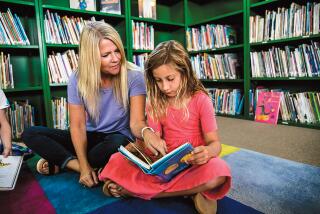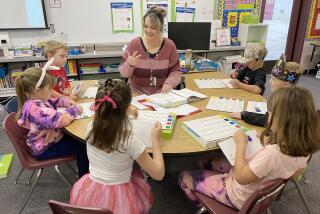California schools are rolling out new standardized tests

Schools across California are set to begin administering new standardized tests Tuesday that are designed to demand more of students and offer a clearer picture of how much they are learning.
More than 3 million students will be tested in English and math through June 6, and for the first time, everyone will take the exams on a computer — either tablet, laptop or desktop. All public school students in grades 3 through 8 are supposed to participate, along with some 9th and 10th graders and most 11th graders.
The new tests are linked to state learning goals that have also been adopted by 44 other states and the District of Columbia. The tests and learning standards have raised philosophical and political questions across the country, but the next few weeks will probably be dominated by pragmatic issues as schools struggle with a new process.
“It’s time to more forward,” state Supt. of Schools Tom Torlakson said Monday during a visit to a school in Culver City. “I’m confident that students in California will embrace this. They’re already embracing technology, not only for taking tests, but for learning.”
Not everyone was so sanguine.
“Many districts are not ready,” said Bill Evers, a former federal assistant secretary of education who reviewed the new learning standards for a state commission.
Testing conditions vary widely from school to school or district to district.
For the results to be most meaningful, Evers said, “standardized testing means standardized conditions.”
Los Angeles Unified had wanted every student to take the test on an individually assigned iPad, but that effort has been delayed. Still, students in at least 47 schools will take the test on their assigned device. At most schools, however, students will share Apple tablets that are carted from room to room. Some campuses will send students to classrooms outfitted with older desktop computers.
“Many students have never used that kind of equipment for tests,” said Judith Perez, president of Associated Administrators of Los Angeles. She’s also heard of security concerns among some principals.
Officials said it would be natural to encounter problems — a main reason why test results won’t count on this first round. Eventually, the scores will be used to rate schools and teachers.
“We are doing a field test. I want to discover the problems now, not next year,” said L.A. schools Supt. John Deasy, adding that for students, “it’s very important they have a level of comfort and experience before the test counts.”
Although students won’t be scored, the tests themselves — and 20,000 questions — will be evaluated to see if they are free of bias and appropriate for the grade and skill level.
Though L.A. Unified is not scheduled to begin its six-week testing period until April 1, students in many other places will log on as soon as Tuesday.
In Baldwin Park, Principal Richard Noblett said that Olive Middle School is “absolutely 100% ready.”
Students have been taking practice exams for months, taking turns on about 100 computers installed in special classrooms, he said.
At nearby Geddes Elementary, even the youngest students have become skilled enough on computers, Principal Irene Garcia said.
“It’s part of that puzzle to prepare them for the future,” Garcia said.
But she’s most interested in the addition of an optional midyear exam, which can provide immediate results to guide teaching.
“It’s a game changer,” Garcia said.
Conscious that many schools lack the latest technology, the test designers have tried to create a system that can get by with limited bandwidth and older software.
But the tests nonetheless represent a sea change from paper and pencil.
The older format consisted of questions that directed students to choose among four or five possible answers.
The new approach is supposed to demand deeper thinking.
A sample sixth-grade math question asks students to evaluate a cereal-box design using a set of rules. Students must explain their answer — a task that requires typing skills. Students then must propose their own design and justify their choice.
They are also asked, for example, to calculate the volume of a cereal box, but no list of possible answers is provided.
Problems with the new format could mask a clear reading of a student’s academic ability, experts say. On the other hand, the program selects items based on the accuracy of a student’s previous answers — a process that should provide a more precise analysis of student skills.
Compton High School Co-Principal Stephen R.D. Glass thinks his students are ready to move from paper to computer, but the experience will help “to make sure our students are ready to take this test.”
More to Read
Start your day right
Sign up for Essential California for news, features and recommendations from the L.A. Times and beyond in your inbox six days a week.
You may occasionally receive promotional content from the Los Angeles Times.








